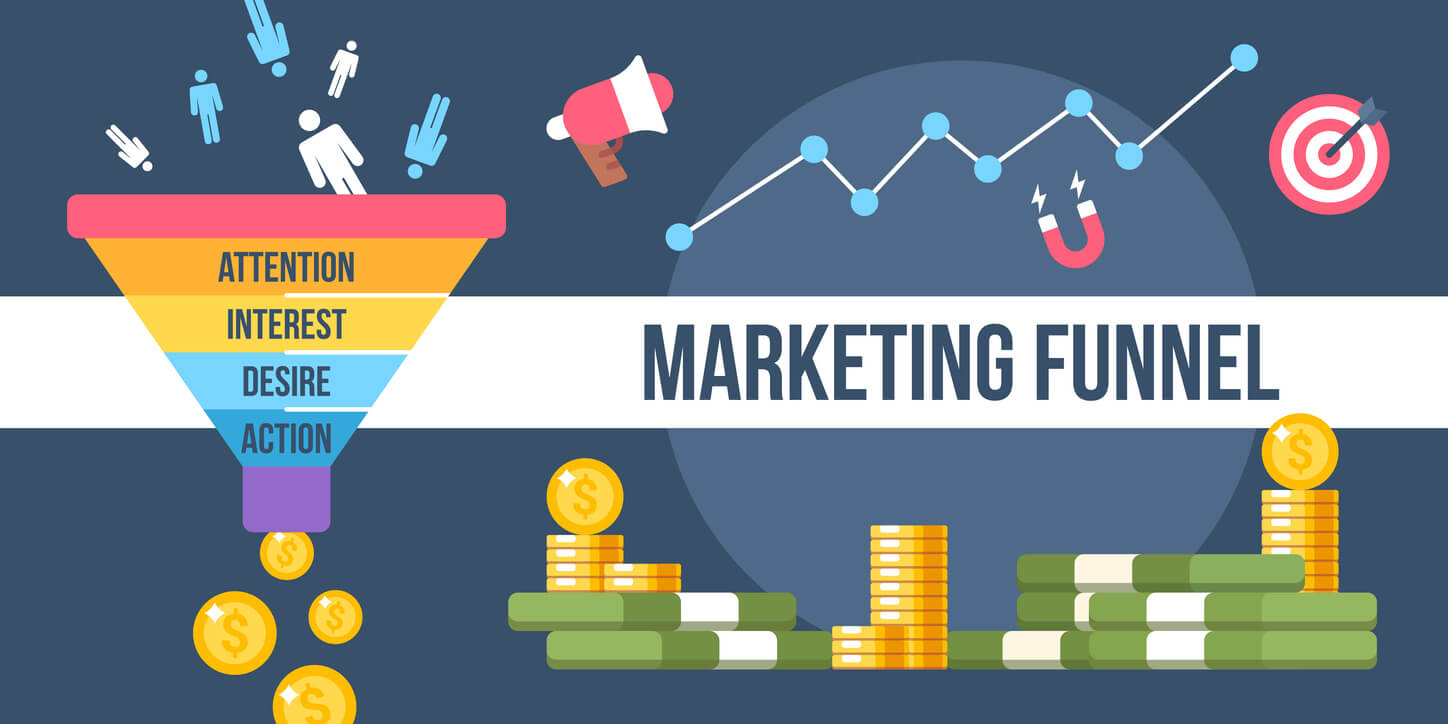
How To Create a Facebook Ads Funnel That Reduces Costs & Attracts More Sales
Many digital advertisers resort to hard-sell advertising tactics on cold prospects to try to get them to purchase a product or service immediately. But when you skip the relationship-building stage of the sales process, it’s like asking a stranger to marry you—you’re likely to scare prospects away and be left with poor results.
Instead of a hard-sell approach, consider guiding prospects through a Facebook ads funnel. We’ve tested a version of this strategy ourselves and found that adding in lead nurturing can increase ROI while decreasing costs.
I’ll describe this strategy in more detail and provide tips on how you can use it to improve results.
3 easy steps for creating a Facebook ads funnel
Not every prospect is ready to become a customer when they first discover your brand. Instead, they may still be researching other solutions or need more information before they can commit. If you solely focus on selling to them, you’re missing out on a large segment of potential buyers.
So what do you do to get these prospects ready to make a purchase? That’s where the marketing funnel comes into play. The marketing funnel organizes prospects into stages based on where they are in the buyer’s journey. It goes from awareness to consideration to conversion.

Organizing your prospects into different stages like this allows you to craft messaging that can honestly speak to their needs, allowing them to transition seamlessly between each stage of the funnel. Through this process, you’re able to develop relationships with potential buyers, gain their trust, and bring them steps closer to your ultimate offering.
How did we use Facebook and email marketing to bring the marketing funnel to life for one of our clients? Here’s the process:
Step 1: Target high-funnel prospects with Facebook video marketing
It’s important to introduce people to your product or service before you ask them to buy from you. This introduction occurs in the Facebook ad brand awareness stage. Our strategy starts with using Facebook’s video views campaign objective to show video ads to top-funnel prospects.
Why video marketing is important
Video marketing is becoming more prominent than ever before. As the average human attention span gets even shorter, companies need to find newer and more creative ways to deliver their message quickly and effectively. Video helps them to do just that. A 30-to-60-second video can share more about your brand’s unique story than a simple image or text ad can, especially when there’s a character limit. For brands with complex products, video also helps make information easier to digest.
Another benefit of video marketing is its ability to evoke emotions from viewers through auditory and visual elements. Video encourages social shares, which can help spread your message even further. We’ve seen a lot of engagement with our video ads, which is valuable even when viewers decide not to click through. When a company provides prospects with useful and interesting information, it helps them build trust and create long-term relationships.
Understanding the video views campaign objective
The “Optimization for Ad Delivery” setting in Facebook allows you to choose the event you want to optimize for in your ad set. Facebook’s goal is to then get you as much of that result as possible (and efficiently). Unlike other campaign objectives, this one specifically optimizes for video views.
Defining your audience
One of the benefits of using this “Optimization for Ad Delivery” setting is that you’re able to reach a wide audience at a significantly lower cost per 1,000 people reached when compared to other campaign types. At this point in the marketing funnel, reaching as many people as possible is our only objective. Why? Because it helps us grow our remarketing audiences, which are key to the next step in our strategy.
Therefore, the audience for your video views campaign should be broader than what you would normally target in a campaign optimized for conversions. When we first started using this campaign objective, we defined our audience by interests and locations. We soon realized that this limited us and that we were missing out on potential prospects who did not fall into our targeted interest categories. As a result, we began targeting people solely by location and then used the data Facebook collected on how long people watched our video to help us gauge interest and relevancy.
The offers in the next two stages of this strategy help narrow this audience down even further. When this audience becomes more targeted, it will grow smaller, which is why having more data to start with is so important. For businesses with very niche audiences, expanding visibility and reach in this first stage is essential; it’s harder for Facebook to optimize and deliver the most efficient results when it’s working with a small audience.
Creating video content
If you’ve already created videos for your website or social media platforms, this strategy is perfect for you. Guess what? You can use that existing content to engage a new audience of prospects.
But what if you don’t already have videos? In that case, we highly recommend you start creating some as soon as possible. Video marketing, including B2B video marketing, is growing every year. If you’re in the B2B industry and need to explain how your product/service works to new prospects, it may be hard through a text ad, especially when there’s a character limit. It’s much more effective to show prospects a 30-second video ad, as it can help increase a user’s understanding of your message.
While other objectives don’t optimize for video views, they are available to support video. Videos are a great way to add value to messaging in every stage for the Facebook ads funnel, including in the campaign type described next.
Step 2: Retarget mid-funnel prospects with lead ads
The next step is to use retargeting to reach the high-funnel prospects who’ve already seen your video view ads. You should present this audience with a mid-funnel asset, such as a demo or whitepaper, in return for their email address or other personal information. Not only will this asset help educate them about your product/service, but it will also allow you to use the information you’ve gathered offline to continue the nurturing process. We recommend using Facebook lead ads for these mid-funnel assets.
How to generate leads on Facebook
Facebook lead ads simplify the conversion process by eliminating the need for a landing page. When a user clicks the call to action button on the ad, a form loads on the screen instead of sending users to a landing page on a website. This feature is valuable for many reasons:
- Facebook is able to use the information it already has on those users (name, email, number, etc.) to pre-populate the form, making a simple process even easier. You can even customize form fields, just like you would on a landing page.
- It leverages the trust people have in the platform. People may be more likely to fill out a form with their personal information on Facebook than on a website they’ve never visited.
- It’s a great option if you don’t have the capabilities to create a landing page or one that’s mobile responsive.
In our client’s case, we used lead ads to invite the people who watched our video ads to join our email newsletter and offered a discount on our services in return. Although we chose to target our video view audience, your audience doesn’t necessarily have to come from the top of the facebook ads funnel; you can also use remarketing audiences from another source, such as your website.
Facebook lead ad retargeting best practices
When creating lead ads on Facebook, consider these tips:
- Limit the number of fields on your lead form; otherwise, users may feel overwhelmed and abandon the form before completion.
- Integrate lead ads with your CRM. This integration eliminates the need for you upload lead ad submissions manually. If you don’t have a CRM, or if there isn’t an integration available, you can use a service like Zapier to automate the process. Zapier will connect to other apps, including Gmail and Google Sheets, to pull the leads out of Facebook regularly.
- Utilize existing email workflows to enhance the nurturing process. Email marketing can be an extremely valuable way to share additional assets that will educate prospects on your product or service and help establish your company as a trustworthy authority. Tracking what assets people download will also help you craft more targeted messaging in the future.
It’s important to note that blog posts are another mid-funnel usable asset in this stage. Instead of sending prospects to a lead form, you would send them to a landing page. While you wouldn’t be collecting any personal information with this asset, you can retarget those visitors later with a lower funnel asset that does utilize a lead form. Multiple touchpoints and resources are an important part of the nurturing process.
The time it takes to nurture prospects will vary by industry and the complexity of your product or service. Prospects who have to make a big investment might need more time and information before they can reach the final stage of the funnel.
Speaking of which…
Step 3: Target low-funnel prospects with an offer
By the time you’ve gotten to this point in the strategy, you will have hopefully nurtured your high-funnel leads into low-funnel prospects. If you’ve done everything right, these people will now know more than just what you offer—they will have gained insights into your business and have a deeper trust for your brand.
Your audiences for this step should include anyone who has not yet shown high buyer intent by this stage of the marketing funnel, whether acquired on Facebook or another source. For example, we created one ad set with our email list and another with website visitors. Make sure to exclude converters from these audiences. The campaign objective you use will depend on your industry; a conversions campaign might make the most sense if people can purchase your product or service online, while B2B marketers might be better off using a lead generation through Facebook campaign to promote a consultation or demo. Either way, you’ll want to encourage users to take the lowest-level action they can complete (and that you can track) online.
As mentioned previously, the time it takes people to get to this stage in the funnel varies. Therefore, run this campaign in tandem with your other remarketing campaigns. This method allows you to nurture prospects who are not ready to convert, while also ensuring that you’re there with your offer the exact moment they are.
Marketing funnel tips discovered through real-world experience
If you take away nothing else from this article, remember these tips:
Use the video views campaign objective to build remarketing lists you can use in this marketing funnel, and in others.
If you’re a local business with multiple locations, organize your Facebook video ads into different ad sets. This organization allows you to easily check on the performance of each specific location and write ad copy that speaks more directly to that audience.
You are able to segment video view remarketing audiences by the length of time someone watched your video (3 seconds, 10 seconds, etc.). Conduct A/B tests to learn which audience is the most effective.
We nurtured our mid-funnel prospects with an email newsletter run by our client. If you don’t have the capabilities or privileges to send emails or newsletters to your prospects, you can use other resources to nurture your leads. Resources could include demos, blog posts, ebooks, white papers, or webinars. The main idea is to provide your prospects with valuable content that they can use to aid their decision process.
When writing ad copy, keep in mind where your audience is in the funnel. If readers are mid-funnel, note that they already know who you are; instead, focus your copy on benefits and additional information. On the other hand, if they’re high-funnel, focus on introducing them to who you are to get them aware of your presence.
The size of your audience can have an impact on your campaign. If Facebook declares your audience too small to be used, try expanding your reach. You’ll be able to narrow down your audience later. For instance, you may not have enough people who watched your entire video. If you run into this problem, try lowering the standard of your targeting specifications (e.g., 10-second video views) or increasing the size of the audience in your video views campaign.
Because this is a newer strategy and every industry is different, it’s important to test constantly (messaging, assets, targeting, etc.). You should also test different videos to see what resonates best with your audience. You won’t learn what the most efficient strategy is without testing.
Conclusion
A marketer’s ultimate goal is to bring in more leads and increase ROI, and a Facebook ads funnel helps them do just that. We tested this nurturing strategy against one that targets all prospects with a low-funnel offer. A nurturing strategy helped us cut our cost per lead in half.
What makes this strategy effective? With it, you can…
- Expand your audience quickly, at a relatively low cost.
- Identify high-funnel prospects without having to rely on interests and other targeting criteria that limit your reach.
- Educate prospects on your product or service in a visual format that enhances understanding.
- Reach the right people, at the right time, with the right message.
- Build trust and create long-term relationships.
We plan to optimize this strategy throughout 2019, and if we find any insightful updates, we’ll be sure to tell you about them.
Need help with a nurturing campaign on Facebook or another platform? Let us know!
Most newsletters suck...
So while we technically have to call this a daily newsletter so people know what it is, it's anything but.
You won't find any 'industry standards' or 'guru best practices' here - only the real stuff that actually moves the needle.







